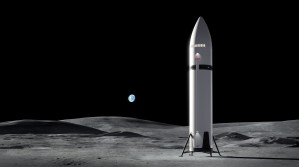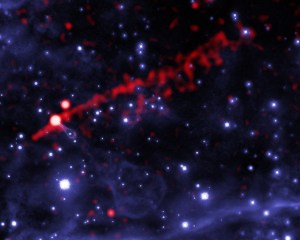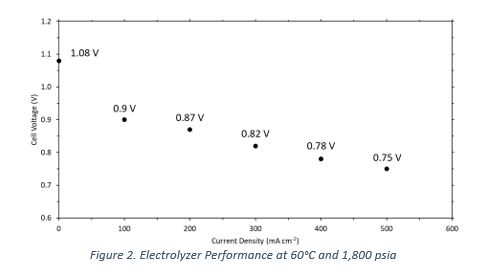Regenerative Fuel Cell System for the Lunar Surface
Dr. Kerrigan Cain (LEX0)
Project Background / Description
NASA is investigating regenerative fuel cell (RFC) systems to provide energy storage on the lunar surface. An RFC is an electrochemical system that operates like a rechargeable battery with the potential to store significantly more energy with lower mass for long-term energy storage needs. The RFC under investigation here is a discrete system that utilizes a fuel cell to produce power and an electrolyzer to recharge. The fuel cell electrochemically reacts hydrogen and oxygen gas to produce power, water, and heat. The electrolyzer electrochemically splits water into hydrogen and oxygen gas when provided power. In addition to the electrochemical subsystems, the RFC system also includes reactant storage, fluid processing, thermal management, power management and distribution, and avionics subsystems.
Challenge Objectives
Complete a trade study analyzing a discrete RFC system for a specified mission located at the lunar South Pole and provide a report summarizing the system design, key assumptions, high-level concept of operations, and the following key performance parameters:
- Specific energy (Units: W∙h/kg) – defined as the net energy storage capacity divided by the mass of the system.
- Specific volume (Units: W∙h/m3) – defined as the net energy storage capacity divided by the volume of the system.
- Round trip efficiency (Units: %) – defined as the system output energy divided by the input energy.
Mission Performance/Requirements.
The RFC system shall be stationary and located near the Shackleton Crater at the lunar South Pole. The RFC system shall provide 10 kW of constant power during the lunar night for a total of 12 lunar day/night cycles. The lunar night (i.e., where the RFC system must provide power) shall be 200 hours and the lunar day (i.e., where solar power is available to recharge the RFC system) shall be 500 hours. Therefore, one lunar cycle is 700 hours. The RFC system shall contain everything necessary to complete the mission without a resupply and/or maintenance mission.
Other relevant requirements/assumptions:
- The RFC system shall be recharged via a photovoltaic array sized to meet the recharging requirements specified for the system.
- The RFC system shall be sized to fit within a 15 m wide conical fairing.
- The local power bus has a voltage of 120 ± 6 VDC.
- Fuel cell stack mass can be approximated by 0.001 kg/W.
- Electrolyzer stack mass can be approximated by 0.02 kg/W.
Key Considerations
- Temperature on the lunar surface varies significantly between day and night. See this article for additional context.
- Fuel cell and electrolyzer performance are shown in Figures 1 and 2. These should be used to approximate performance in the modeled system.
- Redundancy may be important to meet mission needs based on component selection.
- Assumptions will be required. Be sure to explicitly state all assumptions.
System Design
RFC systems are comprised of multiple subsystems and components as shown in Figure 3. RFC system design is a delicate balance of many interrelated factors and design choices often impact subsystems differently (see this article, this article, and this article for additional context). The goal of this project is not to reinvent the wheel but use currently available information to design a system for a relevant mission scenario.
Figure 3. RFC System Functional Elements
Fuel Cell and Electrolyzer Design
To size a fuel cell stack(s):
- Determine the number of cells to fit within the electrical bus potential.
- Adjust cell active area to supply the current required for the mission.
To size an electrolyzer stack(s):
- Determine the required H2 and O2 production rates to recharge system.
- Calculate the required power for one electrolyzer cell from the following equation:
- Calculate the minimum number of cells by using the electrical bus potential.
- Calculate the available current from Steps 2 and 3.
- Calculate the cell active area from the current calculated in Step 4.
Literature Resources
- Paige, D. A., Foote, M. C., Greenhagen, B. T., et al. The Lunar Reconnaissance Orbiter Diviner Lunar Radiometer Experiment. Space Sci Rev 150, 125–160 (2010). https://doi.org/10.1007/s11214-009-9529-2
- Smith, P. J., Zhong, Z., Cain, K. P., et al. Aerospace Regenerative Fuel Cell Fluidic Component Design Challenges. NASA/TM-20210024659
- Smith, P. J., Cain, K. P., Gilligan, R. P., and Jakupca, I. J. Lunar Equator Regenerative Fuel Cell System Efficiency Analysis. NASA/TM-20210014627
- Smith, P. J., Cain, K. P., Gilligan, R. P., and Jakupca, I. J. Lunar South Pole Regenerative Fuel Cell System Efficiency Analysis. Conference Paper
Click here to register for the Space II: Regenerative Fuel Cell System for the Lunar Challenge
Application/Registration Information
Contact Information
Catherine Graves, Ph.D. STEM
Integration Manager
Email: grc-university-design-challenge@mail.nasa.gov
Glenn Research Center – Office of STEM Engagement
Phone: (216) 433-6656
Email: grc-university-design-challenge@mail.nasa.gov
Latest Content
Stay up-to-date with the latest content from NASA as we explore the universe and discover more about our home planet.

Earth planning date: Monday, Nov. 18, 2024 I am in the U.K., where we are approaching the time when trees…

NASA is working with U.S. industry to develop the human landing systems that will safely carry astronauts from lunar orbit…

Normally found only in heavy metal bands or certain post-apocalyptic films, a “flame-throwing guitar” has now been spotted moving through…































